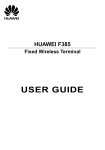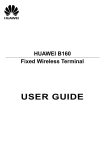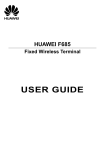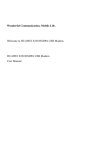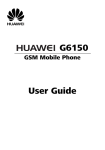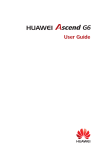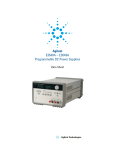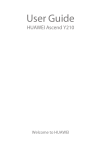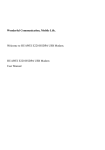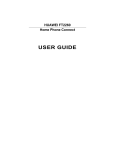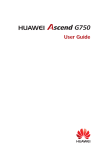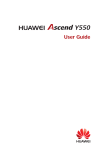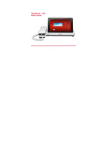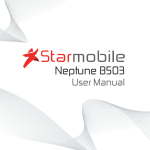Download Wonderful Communication, Mobile Life
Transcript
Wonderful Communication, Mobile life. HUAWEI U1250-9 Mobile Phone Users Guide Copyright © 2010 Huawei Technologies Co., Ltd. All Rights Reserved No part of this document may be reproduced or transmitted in any form or by any means without prior written consent of Huawei Technologies Co., Ltd. The product described in this manual may include copyrighted software of Huawei Technologies Co., Ltd and possible licensors. Customers shall not in any manner reproduce, distribute, modify, decompile, disassemble, decrypt, extract, reverse engineer, lease, assign, or sublicense the said software, unless such restrictions are prohibited by applicable laws or such actions are approved by respective copyright holders under licenses. Trademarks and Permission , HUAWEI and are trademarks or registered trademarks of Huawei Technologies Co., Ltd. Other product, service and company names mentioned are the property of their respective owners. Notice Some features of the product and its accessories described herein rely on the software installed, capacities and settings of local network, and may not be activated or may be limited by local network operators or network service providers, thus the descriptions herein may not exactly match the product or its accessories you purchase. Huawei Technologies Co., Ltd reserves the right to change or modify any information or specifications contained in this manual without prior notice or obligation. NO WARRANTY THE CONTENTS OF THIS MANUAL ARE PROVIDED “AS IS”. EXCEPT AS REQUIRED BY APPLICABLE LAWS, NO WARRANTIES OF ANY KIND, EITHER EXPRESS OR IMPLIED, INCLUDING BUT NOT LIMITED TO, THE IMPLIED WARRANTIES OF MERCHANTABILITY AND FITNESS FOR A PARTICULAR PURPOSE, ARE MADE IN RELATION TO THE ACCURACY, RELIABILITY OR CONTENTS OF THIS MANUAL. TO THE MAXIMUM EXTENT PERMITTED BY APPLICABLE LAW, IN NO CASE SHALL HUAWEI TECHNOLO-GIES CO., LTD BE LIABLE FOR ANY SPECIAL, INCIDENTAL, INDIRECT, OR CONSEQUENTIAL DAMAGES, OR LOST PROFITS, BUSINESS, REVENUE, DATA, GOODWILL OR ANTICIPATED SAVINGS. Import and Export Regulations Customers shall comply with all applicable export or import laws and regulations and will obtain all necessary governmental permits and licenses in order to export, re-export or import the product mentioned in this manual including the software and technical data therein. Safety Precautions Please read the safety precautions carefully to ensure the correct and safe use of your wireless device. For detailed information, refer to the section “Warnings and Precautions”. Do not switch on your phone when it is prohibited to use mobile phones or when the phone may cause interference or danger. Switch off your phone near high-precision electronic devices. The phone may affect the performance of these devices. Do not use your phone while driving. Do not attempt to disassemble your phone or its accessories. Only qualified personnel are allowed to service or repair the phone. Follow any rules or regulations in hospitals and health care facilities. Switch off your phone near medical apparatus. Do not place your phone or its accessories in containers with strong electromagnetic field. Switch off your phone in aircraft. The phone may cause interference to control signals of the aircraft. Do not place magnetic storage media near your phone. Radiation from the phone may erase the information stored on them. Do not put your phone in a high- temperature place or use it in a place with flammable gas such as a gas station. Observe any laws or regulations on the use of wireless device. Respect others’ privacy and legal rights when using your wireless device. Keep your phone and its accessories away from children. Do not allow children to use your phone without guidance. Strictly follow the relevant instructions of this manual while using the USB cable. Otherwise your phone or PC may be damaged. Use only approved batteries and chargers to avoid the risk of explosions. Contents 1. Introduction Packing List ................... 1 Your Phone .................... 2 Security ........................ 10 Text Input ..................... 11 2. Customized Settings Phone Settings ............ 13 Display Settings ........... 13 Network Settings .......... 14 3. Call Function Managing Contacts ...... 15 Viewing the Call Records ........................ 16 Making or Ending a Call ............................... 16 Answering or Rejecting a Call ............................ 16 4. Message Function Message ...................... 18 Email ............................ 19 5. Connection Function Connectivity Settings ... 20 USB .............................. 20 ® Bluetooth .................... 22 6. Entertainment Function Music ............................ 26 Camera ........................ 26 Browser ........................ 27 7. Business Function File Management ......... 29 8. Warnings and Precautions Electronic Device ......... 30 Medical Device............. 30 Potentially Explosive Atmospheres ................ 30 Traffic Security ............. 31 Operating Environment 32 Preventing Hearing Damage ....................... 33 Safety of Children ........ 33 Accessories .................. 33 Battery and Charger .... 33 Clearing and Maintenance ..................................... 34 Emergency Call............ 35 Certification Information (SAR) ........................... 36 FCC Statement ............ 36 1. Introduction Your Phone can operate in many countries in which the following networks exist, automatically switching between UMTS 1700/2100 and GSM/GPRS/EDGE 850/900/1800/1900 networks. NOTE: The services supported by your phone should be also supported by the network from where you use the phone. For details, contact your service provider. Packing List Your phone package box contains the following: 1. 2. 3. 4. 5. 6. One mobile phone One travel charger One Li-ion battery One Quick Start Guide One USB data cable One wired headset 1 Your Phone Your Phone Appearance and Keys 1. Charger connector/ Cable connector 2. Headset Jack 3. Earpiece 4. Left function key 5. Music key 6. Send key 7. Scroll key 8. Power/End 9. Clear key 2 Your Phone key 10. Right function key 11. OK key 12. Volume keys Left function key Activate the function indicated at the left of the prompt bar. Music key Access the music menu in standby mode. Send key • Make or Answer a call. • Enter the Calls screen in standby mode. Scroll key • Scroll through a menu. • Access the corresponding shortcut menu in standby mode. Right function key Activate the function indicated at the right of the prompt bar. Clear key Delete a character before the cursor. 3 Your Phone Power/ End key • End an ongoing call or reject an incoming call. • Return to the standby mode. • Press and hold it to power on or power off the phone. OK key • Start the selected function in the menu. • Access the main menu in standby mode. SIM Card and Memory Card Load your SIM card before using your phone. Only unload the SIM card and the battery after powering off your phone. To use the SIM card properly, please read the following instructions carefully. NOTE: • • Keep the SIM card out of the reach of children. The SIM card and its metal contacts can be easily damaged by scratching or bending. Ensure care when you carry, load or remove it. • Always disconnect the charger from the phone before loading or removing the SIM card. To load or remove the SIM card, please refer to the following figures. 4 Your Phone Your phone supports a memory card (microSD) with a capacity up to 8 GB. To load or remove the memory card, please refer to the following figure. Antenna The picture shows the antenna area marked in grey. Please do not touch the antenna unnecessarily. 5 Your Phone Charging the Battery NOTE: • • • • • When you charge the battery for the first time, please charge it for a minimum of 12 hours. The battery discharges even while not being used. If you have not used it for a long time, please recharge it first. Do not strike, throw or cause any kind of violent shock to the battery, otherwise liquid leakage, body damage, overheating, fire or explosion may occur. The battery can be recharged but eventually wears out. If the battery lasts for a shorter time period than usual after being charged normally, replace it with a battery of the same type. Charge the battery by using the charger supplied with your phone. Before charging the battery with a cable charger, ensure that the battery has been properly placed into your phone. To charge the battery, first plug in the charger connector to a power socket, and then insert the plug of the cable 6 Your Phone into the connector of the phone as shown in the following figure. The figure is for reference only. The actual appearance is subject to your mobile phone and supplied accessories. NOTE: • • • The plug of the charger is in trapezium shape. Reversely inserting the plug may damage the mobile phone and charger. When the battery power level is very low, the phone makes alert sounds and displays a prompt. When the battery power level is too low, the phone will power off automatically. When the battery is being charged, the charging indicator blinks continuously. When the charging indicator stops blinking, it indicates that the battery is full. 7 Your Phone Screen 1. Icon bar 2. Desktop 3. Prompt bar The icon bar displays the phone status. The following table illustrates the icons that may appear on this bar. Indicates signal strength. The normal profile is activated. Indicates power level of the battery. The headset is plugged in. The phone is currently in a GSM or WCDMA network. Your PC connects to the Internet through your phone. 8 Your Phone You are using the roaming service. You have new text messages. Bluetooth is enabled. You have new voice mails. Call line 2 is enabled currently. You have new multimedia messages. Forwarding all incoming voice calls to line 1 or line 2. You have new Emails. The phone is in a call. You have new PUSH messages. Alarm clock is enabled. 9 Security Security Phone/SIM Card Security Settings NOTE: • For certain SIM cards, you need to enter the PIN2 code to use certain special functions. • If you enter a wrong PIN code or wrong PIN2 code for three consecutive attempts, the SIM card is locked. To unlock the SIM card, enter the PIN Unblocking Key (PUK) code or PUK2 code. • The PIN code, PIN2 code, PUK code, or PUK2 code is provided together with the SIM card. For details, consult your service provider. • The initial phone password of the phone is 0000. Select Settings > Security. • Reset your phone to the factory settings. • Enable or disable the "Phone lock" and "PIN lock". • Modify the phone password and PIN2 code. • If your SIM card supports the Fixed Dialer Number (FDN) function, you can set the limit for phone numbers. Digital Rights Management Select Settings > License setting. Enter the correct phone password and press OK key to confirm, and you can select roaming network or delete all licenses. Digital Rights Management (DRM) can protect the digital content from piracy and protect the provider’s interests. The digital content includes Java applications and 10 Text Input multimedia content such as images, audio and video. If the protected content cannot be accessed, it indicates that the corresponding license is overdue or used up. Text Input NOTE: While entering text: • • • • Press the * key to switch between input methods. Press and hold the * key to enable or disable the T9 input mode. Press repeatedly the * key and you will see "abc","Abc", "ABC" or "123" on the upper left corner of the screen successively. It indicates the words to be entered will be in lower case, first letter capitalized or in upper case. Press the # key to display the symbols list. Press and hold the # key to set the input language. Press the Clear key to delete the letter before the cursor. ® T9 Input Method With the T9 input method, you can easily and quickly enter words. T9 is a predictive text entry mode. Press the relevant key that corresponds to the desired letter and T9 will offer you candidate words. Press each key carrying the desired letter once, and then the predictive text scheme will present the candidate words composed by the letters you have entered in the drop-down menu. 11 Text Input Traditional Input Method When T9 input method is off, you can use the traditional input method for entering alphabetic characters. Repeatedly press the key that carries the letter to be entered when it appears on the screen. Number Input Method In a text editing screen, press and hold the character/number keys to enter corresponding numeric characters. You can also press successively the * key to switch to the "123" numeric input method, and enter corresponding numeric characters by pressing the character/number keys. Symbol Input Method You can press the # key to display the symbols list and then select symbols to input. You can also press the key with number 1 to input the commonly-used symbols in a text editing screen (except numeric input method). 12 2. Customized Settings Phone Settings Select Settings > Phone settings. You can change the settings of the phone. • Set the system date and time format of the phone. If you have removed the battery from the mobile phone, you may need to set the time after power on the mobile phone. • Select different profiles for the phone to suit different environmental situations. • Set the phone language. • Set the language used to enter text. • Set the keypad tone of the phone. • Set the keypad lock period. • Assign the frequently used functions to the scroll keys as shortcut keys. • Set your phone to power on or off automatically. NOTE: In the standby mode, you can press and hold the # key to switch between the current profile and the silent profile. If the current profile is offline, you cannot use this function. Display Settings Select Settings > Display settings. You can change the settings for the phone display. • Set the wallpaper layout for the home screen. • Set the theme of the phone. • Set the brightness of the screen. 13 Network Settings • • • • • Turn the keypad backlight on or off. Set the backlight delay time for the screen. Turn the alert on and off. Enter a greeting message that appears on the screen when you power on your phone. Enter a message that appears on the screen when you power off your phone. Network Settings Select Settings > Network. You can change the settings for the network. Four options are available: Mode, Select network, Cell information, and Operator list. 14 3. Call Function Managing Contacts Creating a Contact To add a new contact, perform one of the following operations: • • • Enter a number in standby mode, and then select Options > Save number. Select Contacts > Add new contact. Select a record from Calls screen, and then select Options > Save number. Searching for a Contact You can find a contact from the contacts list easily and quickly by using this function on the Contacts screen. Select Options > Advanced > Search contacts, and then enter the contact name you are searching for. The contact is displayed. You can also use quick search in the contacts list screen. You can find a contact by entering the initials of the first name or the last name of the contact. Managing a Group In the Contacts screen, press the left or right scroll key to select Groups. And then select a group: • Select Options for the following options: Details, Rename, Send message, Set ringtone and Remove all members. 15 Viewing the Call Records • Press OK key to view the details. And then select Add or select Options > Add contact to add a contact into the group. To delete a group member, select a member from the group member list, and then select Options > Remove. Viewing the Call Records Select Calls in the main menu and then press the left or right scroll key to select All calls, Missed, Received or Dialed. Then select Options for the following operations. • • • • • • Send a message or MMS. Save the number of the selected record. Make a voice call. Delete the selected record. Mark or unmark a record or all records. Set the display mode of all records or view calls status. Making or Ending a Call 1. 2. Enter a number or select a contact. Press the send key to make a call. Press the end key to terminate the call. Answering or Rejecting a Call 1. Answer a call according to the different answer modes. • If the answer mode is Any key, press any key except the end key. 16 Answering or Rejecting a Call • • 2. If the answer mode is Send key, press the send key. If the headset is in use, press the control key on the headset. Press the end key or select Options > Reject to reject a call 17 4. Message Function Message The screen displays the number of words or bytes of a message. If the characters you enter exceed this limit, the text is divided into two or more continuous messages when it is sent. Sending a Message 1. 2. 3. 4. Select Messaging > Create message to access the message editing screen. While editing a message: • You can press down scroll key to add attachment files. After editing the message, press OK key to add a recipient’s number. Press OK key to send the message. Viewing a Message Your phone provides four mailboxes for messages. Inbox stores received messages. Drafts stores created and saved messages. Outbox stores the messages that failed to be sent. Sent stores sent messages. 1. 2. Select a mailbox from Messaging. Select a message, and then select Options to perform the operations of the option list. 18 Email NOTE: If your phone is enabled with the broadcast function, select Messaging > Broadcast Inbox to view broadcast messages. Email Sending an Email 1. 2. 3. 4. Select Email > Create Email to access the email editing screen. Select To and press OK key. Enter recipient or add recipient from contacts. In the email editing screen: • Select Subject to edit the contents. • Select Text Message to edit the content. In the email editing screen, select Options > Send to send the email. Viewing an Email Your phone provides five mailboxes for Email. Inbox stores received emails. Drafts stores created and saved emails. Outbox stores the emails failed to be send. Sent stores sent emails. Blocked stores screened emails. 1. 2. Select a mailbox from Email. Select an email message. 19 5. Connection Function Connectivity Settings Select Settings > Connectivity. You can set the Bluetooth, network access point or select data connection modes. NOTE: • • • • Your phone supports USB 2.0. Your phone supports plug-and-play function. The PC assistant installation program and USB driver are embedded in the mobile phone. The PC Options software supplied on your phone will run automatically after you connect your phone to the PC. USB You can synchronize data between your phone and PC, surf the Internet with your phone and read the memory card by USB cable. 1. 2. 3. Connect your phone with a PC through USB cable delivered with your phone. The PC Options software supplied on your phone will run automatically. Select PC Assistant button to perform the USB-Based Synchronization operation; select HUAWEI Mobile Connect via the phone to perform the USB-Based Internet Access operation; and select File Transfer to perform the microSD Card Reader operation. 20 USB 4. For the first time, follow the guide to complete the installation. NOTE: • • • To connect your phone with a PC through USB cable, first connect the USB connector to your phone, and then connect the other end of the cable to the PC. To disconnect your phone from the PC, first disable the PC Assistant, then disconnect the USB connector from the PC, and finally disconnect the USB cable from your phone. If the PC cannot recognize your phone when connecting through the USB cable, power off and restart the PC and then retry. Please do not plug the USB cable in and out of your phone frequently. USB-Based Synchronization For details of the operation, refer to the Help of the PC Assistant. USB-Based Internet Access To access the Internet by USB, make sure that your PC supports the USB function and your SIM card supports the Internet access service. You may need the username and the password. For details, please contact your service provider. NOTE: • Only Windows 2000, Windows XP and Windows Vista are supported. 21 Bluetooth® • You can also use the built-in Internet wizard of the Windows operating system to access the internet. microSD Card Reader The function of microSD card reader and the other functions using the USB cable are incompatible. If you enable the microSD card reader, other functions using the USB cable are unavailable. Bluetooth® You may use the built-in Bluetooth function of your phone to synchronize data between a PC and your phone, or use the built-in modem of your phone to access the Internet with a PC, or exchange data with other Bluetooth devices. You can also talk by using a Bluetooth headset or Bluetooth loudspeaker. NOTE: • • The Bluetooth function supported by your Phone meets the requirements of Bluetooth Specification 2.0. It can work successfully only if you use it with compatible Bluetooth devices. For more information, refer to the user manuals of related devices, or consult the manufacturer of related devices. You can select Settings > Connectivity > Bluetooth > Visibility to set whether your phone can be found by other devices when the Bluetooth function is enabled. Bluetooth-Based Synchronization 22 Bluetooth® Your phone can respond to data synchronization requests from a PC. To operate the Bluetooth synchronization with your phone, your PC needs to support Bluetooth function. 1. 2. 3. 4. 5. Install the PC Assistant supplied on your phone. Select Settings > Connectivity > Bluetooth > Switch On/Off > On to enable the Bluetooth function. Run the driver software for Bluetooth on the PC, and pair the phone. After the PC detects and recognizes the phone serial port service, activate the Bluetooth serial port service on the phone. Run the PC Assistant on the PC. You can now operate the synchronization. For details of the operation, refer to the Help of the PC Assistant Bluetooth-Based Data Transfer You can exchange data between your Bluetooth phone and other Bluetooth devices. If you want to exchange data between your phone and another device, that device must support Bluetooth and the Bluetooth function must be enabled. 1. Select Settings > Connectivity > Bluetooth > Switch On/Off > On to enable the Bluetooth function. 2. Select Settings > Connectivity > Bluetooth > My devices. Select Search for devices to search a Bluetooth device. When the Bluetooth device is found for the first time, authentication is required. Now you can exchange data between your phone and the other Bluetooth device. 23 Bluetooth® Bluetooth-Based Internet Access To access the Internet by Bluetooth, make sure that your PC supports the Bluetooth function and your SIM card supports the Internet access service. To access the Internet, you may need the username and the password. For details, please contact your service provider. 1. 2. 3. 4. Select Settings > Connectivity > Bluetooth > Switch On/Off > On to enable the Bluetooth function. Select Settings > Connectivity > Modem and set the port to Modem via Bluetooth. Make sure that Bluetooth modem is in Device Manager/Modem of your PC. Run the driver software for Bluetooth on the PC, and pair the phone. After the PC has detected the dial-up network service, you can activate this service. Then you can create Bluetooth-based internet access through the built-in Internet wizard of the Windows operating system, or the Internet wizard supplied with the Bluetooth drive suite of the PC. NOTE: Only Windows 2000, Windows XP and Windows Vista are supported. The Bluetooth Headset You can answer a call by a Bluetooth headset or Bluetooth loudspeaker. For details, refer to the corresponding user manual of a Bluetooth headset or loudspeaker. 24 Bluetooth® 1. 2. Set the Bluetooth headset to the status for detecting. Select Settings > Connectivity > Bluetooth > Switch On/Off > On to enable the Bluetooth function. 3. Select Settings > Connectivity > Bluetooth > My devices. Select Search for devices to search a Bluetooth device. When a Bluetooth device is found for the first time, authentication is required. 4. If a Bluetooth headset is detected and recognized for the first time, it should be authenticated by a PIN code. Now you can use the Bluetooth headset as the connection has been established between your phone and the Bluetooth headset. The Bluetooth headset should be set to the status for detecting only when authentication is needed. Once the headset has been authenticated, you just need to turn on your Bluetooth headset. For more information, refer to the user manual of your Bluetooth headset. NOTE: The procedure for using a Bluetooth loudspeaker is similar to that for a Bluetooth headset. For details, refer to the user manual supplied with your Bluetooth loudspeaker. 25 6. Entertainment Function NOTE: • Selecting Entertainment, you can enjoy games, videos, applications with your phone. Music Select Music. You can play different kinds of music, sort music by artists, albums, and genres, set the play list, and view the latest play list. During music playing, you can perform the following operations: • • Follow the displayed prompts and use the scroll key to perform corresponding operations. Select Options to perform the operations in the list. Camera Select Camera to start the camera. In the camera viewfinder screen, press the right scroll key to switch to the video camera function. Operations in the Viewfinder Screen When the camera is started, you can press OK key to take a picture. Or press the right scroll key to switch to the video camera function (when the tool bar is closed). Then, you can press OK key to start recording the video. In the viewfinder screen, you can: 26 Browser • • • Press the up or down scroll key to adjust the brightness. Press the volume keys to adjust the focus. Select Options to display the tool bar or select Back to close the tool bar. This tool bar is used to set the parameters of the camera or the video camera. After taking a picture, the picture taken is auto saved to the My Files/Pictures directory. During the recording, you can perform the following operations. • • Pause and then to start recording again. Cancel the recording. Browser The built-in browser makes it easy to browse any webpage. You can access the browser by selecting Browser from the main menu. 27 7. Business Function Calendar Management Using the Alarm Clock Select Organizer & Tools > Alarms. You can select one alarm from the list, and then press OK key to set an alarm clock. When it is time for an alarm clock to ring, the selected alarm tone is played and a prompt is displayed. You can stop the ringing and snooze by pressing any key (except the left function key and power key). If your phone is powered off, the alarm clock will still ring. When the alarm rings, you can choose to power on the phone. Select an alarm clock from the list, and press the left function key to deactivate it. Using the Calendar Select Organizer & Tools > Calendar. You can select Options > New to create the schedule events for the current day. The schedule prompt is the same with alarm prompt. Creating a Task Select Organizer & Tools > Task. To define a new task, press OK key or select Options > New on the Tasks screen. The task prompt is the same with alarm prompt. 28 File Management Creating a Memo Select Organizer & Tools > Memo. You can store important events on your phone. File Management Select My Files. You can manage the Pictures, Ringtones, Music, Videos, Themes, and Others files conveniently. Select a file, then select Options to perform the operations of the list. NOTE: • • Some sound files are protected by Digital Rights Management (DRM), and may not be able to be used as a ringtone. When the phone detects and recognizes the memory card, Memory card is displayed as a tab on the My Files screen. 29 8. Warnings and Precautions This section contains important information pertaining to the operating instructions of your device. It also contains information about how to use the mobile safely. Read this information carefully before using your device. Electronic Device Power off your device if using the device is prohibited. Do not use the device when using the device causes danger or interference with electronic devices. Medical Device • • • Follow rules and regulations set forth by hospitals and health care facilities. Do not use your device when using the device is prohibited. Pacemaker manufacturers recommend that a minimum distance of 15 cm be maintained between a device and a pacemaker to prevent potential interference with the pacemaker. If you are using a pacemaker, use the device on the opposite side of the pacemaker and do not carry the device in your front pocket. Some wireless devices may affect the performance of the hearing aids. For any such problems, consult your service provider. Potentially Explosive Atmospheres Power off your device in any area with a potentially explosive atmosphere, and comply with all signs and instructions. Areas 30 Traffic Security that may have potentially explosive atmospheres include the areas where you would normally be advised to turn off your vehicle engine. Triggering of sparks in such areas could cause an explosion or a fire, resulting in bodily injuries or even deaths. Do not power on your device at refueling points such as service stations. Comply with restrictions on the use of radio equipment in fuel depots, storage, and distribution areas, and chemical plants. In addition, adhere to restrictions in areas where blasting operations are in progress. Before using the device, watch out for areas that have potentially explosive atmospheres that are often, but not always, clearly marked. Such locations include areas below the deck on boats, chemical transfer or storage facilities, and areas where the air contains chemicals or particles such as grain, dust, or metal powders. Ask the manufacturers of vehicles using liquefied petroleum gas (such as propane or butane) whether this device can be safely used in their vicinity. Traffic Security Observe local laws and regulations while using the device. In addition, if using the device while driving a vehicle, comply with the following guidelines: • • • • • Concentrate on driving. Your first responsibility is to drive safely. Do not talk on the device while driving. Use hands-free accessories. When you have to make or answer a call, park the vehicle at the road side before using your device. RF signals may affect electronic systems of motor vehicles. For more information, consult the vehicle manufacturer. In a motor vehicle, do not place the device over the air bag or in the air bag deployment area. Otherwise, the device 31 Operating Environment • may hurt you owing to the strong force when the air bag inflates. Do not use your device while flying in an aircraft. Power off your device before boarding an aircraft. Using wireless devices in an aircraft may cause danger to the operation of the aircraft and disrupt the wireless telephone network. It may also be considered illegal. Operating Environment • • • • • • Do not use or charge the device in dusty, damp or dirty places or places with magnetic fields. Otherwise, it may result in a malfunction of the circuit. The device complies with the RF specifications when the device is used near your ear or at a distance of 1.5 cm from your body. Ensure that the device accessories such as a device case and a device holster are not composed of metal components. Keep your device 1.5 cm away from your body to meet the requirement earlier mentioned. On a stormy day with thunder, do not use your device when it is being charged, to prevent any danger caused by lightning. When you are on a call, do not touch the antenna. Touching the antenna affects the call quality and results in increase in power consumption. As a result, the talk time and standby time are reduced. While using the device, observe the local laws and regulations, and respect others' privacy and legal rights. Keep the ambient temperature between 0°C and 45 °C while the device is being charged. Keep the ambient temperature between -10 ℃ to 45 ℃ for using the device powered by battery. 32 Preventing Hearing Damage Preventing Hearing Damage Using a headset at high volume can damage your hearing. To reduce the risk of damage to hearing, lower the headset volume to a safe and comfortable level. Safety of Children Comply with all precautions with regard to children's safety. Letting the child play with your device or its accessories, which may include parts that can be detached from the device, may be dangerous, as it may present a choking hazard. Ensure that small children are kept away from the device and accessories. Accessories Use the accessories made only by the manufacturer. Using accessories of other manufacturers or vendors with this device model may invalidate any approval or warranty applicable to the device, result in the non-operation of the device, and cause danger. Battery and Charger • • • Unplug the charger from the electrical plug and the device when not in use. The battery can be charged and discharged hundreds of times before it eventually wears out. When the standby time and talk time are shorter than the normal time, replace the battery. Use the AC power supply defined in the specifications of the charger. An improper power voltage may cause a fire or a malfunction of the charger. 33 Clearing and Maintenance • • • • • • Do not connect two poles of the battery with conductors such as metal materials, keys or jewelries. Otherwise, the battery may be short-circuiting and may cause injuries and burns on your body. Do not disassemble the battery or solder the battery poles. Otherwise, it may lead to electrolyte leakage, overheating, fire, or explosion. If battery electrolyte leaks out, ensure that the electrolyte does not touch your skin and eyes. When the electrolyte touches your skin or splashes into your eyes, wash your eyes with clean water immediately and consult a doctor. If there is a case of battery deformation, color change, or abnormal heating while you charge or store the battery, remove the battery immediately and stop using it. Otherwise, it may lead to battery leakage, overheating, explosion, or fire. If the power cable is damaged (for example, the cord is exposed or broken), or the plug loosens, stop using the cable at once. Otherwise, it may lead to an electric shock, a short circuit of the charger, or a fire. Do not dispose of batteries in fire as they may explode. Batteries may also explode if damaged. Clearing and Maintenance • • The device, battery, and charger are not water-resistant. Keep them dry. Protect the device, battery, and charger from water or vapor. Do not touch the device or the charger with a wet hand. Otherwise, it may lead to a short circuit, a malfunction of the device, and an electric shock to the user. Do not place your device, battery, or charger in places where it can get damaged because of collision. 34 Emergence Call • • • • • • Otherwise, it may lead to battery leakage, device malfunction, overheating, fire, or explosion. Do not place magnetic storage media such as magnetic cards and floppy disks near the device. Radiation from the device may erase the information stored on them. Do not leave your device, battery, and charger in a place with an extreme high or low temperature. Otherwise, they may not function properly and may lead to a fire or an explosion. When the temperature is lower than 0°C, performance of the battery is affected. Do not place sharp metal objects such as pins near the earpiece. The earpiece may attract these objects and hurt you when you are using the device. Before you clean or maintain the device, power off the device and disconnect it from the charger. Do not use any chemical detergent, powder, or other chemical agents (such as alcohol and benzene) to clean the device and the charger. Otherwise, parts of the device may get damaged or a fire can be caused. You can clean the device and the charger with a piece of damp and soft antistatic cloth. Do not dismantle the device or accessories. Otherwise, the warranty on the device and accessories is invalid and the manufacturer is not liable to pay for the damage. Emergency Call You can use your device for emergency calls in the service area. The connection, however, cannot be guaranteed in all conditions. You should not rely solely on the device for essential communications. 35 Certification Information (SAR) Certification Information (SAR) This mobile device meets guidelines for exposure to radio waves. Your device is a low-power radio transmitter and receiver. As recommended by international guidelines, the mobile device is designed not to exceed the limits for exposure to radio waves. These guidelines were developed by the independent scientific organization International Commission on NonIonizing Radiation Protection (ICNIRP) and include safety measures designed to ensure safety for all users, regardless of age and health. The Specific Absorption Rate (SAR) is the unit of measurement for the amount of radio frequency energy absorbed by the body when using a device. The SAR value is determined at the highest certified power level in laboratory conditions, but the actual SAR level of the device when being operated can be well below the value. This is because the device is designed to use the minimum power required to reach the network. The SAR limit adopted by USA and Canada is 1.6 watts/ kilogram (W/kg) averaged over one gram of tissue. The highest SAR value reported to the FCC and IC for this device type when tested for use at the ear is X.XX W/kg, and when properly worn on the body is X.XX W/kg. FCC Statement This equipment has been tested and found to comply with the limits for a Class B digital device, pursuant to Part 15 of the FCC Rules. These limits are designed to provide reasonable protection against harmful interference in a residential installation. This equipment generates, uses and can radiate 36 FCC Statement radio frequency energy and, if not installed and used in accordance with the instructions, may cause harmful interference to radio communications. However, there is no guarantee that interference will not occur in a particular installation. If this equipment does cause harmful interference to radio or television reception, which can be determined by turning the equipment off and on, the user is encouraged to try to correct the interference by one or more of the following measures: • Reorient or relocate the receiving antenna. • Increase the separation between the equipment and receiver. • Connect the equipment into an outlet on a circuit different from that to which the receiver is connected. • Consult the dealer or an experienced radio/TV technician for help. This device complies with Part 15 of the FCC Rules. Operation is subject to the following two conditions: (1) this device may not cause harmful interference, and (2) this device must accept any interference received, including interference that may cause undesired operation. Warning: Changes or modifications made to this device not expressly approved by Huawei Technologies Co., Ltd. may void the FCC authorization to operate this device. V100R001_01 31010XXX 37











































